Are you watching your cholesterol? Then you might be interested to read this story, describing the American Heart Association’s role in creating mass cholesterol-phobia, including evidence that they actively suppressed information that would have changed the course of medical history.
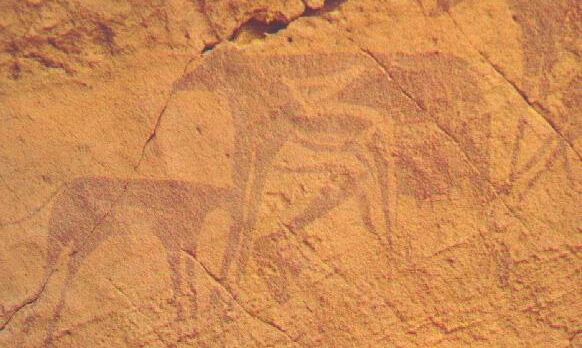
Is dairy paleo? (part 2) Revising history with new perspectives on flocks of goats, femur bones and feckless nutritionism
Table of Contents
When did humans first start drinking milk and other dairy products? If it began in the Paleolithic era, as I believe, then our genes have been depending on these nutrients for thousands of generations.
Various historical writers have tried to sell us on the idea that people were hunter-gatherers for an extended period of time and then BAM! abruptly switched to farming the minute they learned to smelt bronze and make tools that, among other things, enabled them to put their suddenly domesticated animals to work in the fields. I have to say find it unlikely that so many major cultural changes would have taken place simultaneously.
I know, you’re probably thinking Dr Cate, you’re not a historian. Who cares what you think about history? Here’s the thing: The unraveling of history’s big questions requires input from many scientific specialists and, given the fact that there are so many claims made around the health implications of eating meat and dairy products, the history of animal domestication is very much a medically relevant topic.
This article is continued below...(scroll down)
So back to my point. It’s hard to harness an animal to a plow. You need leatherworkers, metalsmiths, a ton of stored seeds to plant in the fields, places to store the seeds and then to store the food that grows and on and on.
Much easier than all that is shepherding. Find a dog to train, provide it with food as long as it keeps an eye on some sheep for you, and take a nap. In other words, outsource your labor to someone else. You can even skip the dog if you can’t find one and watch over the sheep yourself. Either way, shepherding represents a gradual strengthening of the human-animal interrelationship, and this is one reason that envisioning an extended period of herding and gathering as an intermediate step in the human cultural arc between hunter and farm-laborer makes for a version of history that I find more logically appealing.
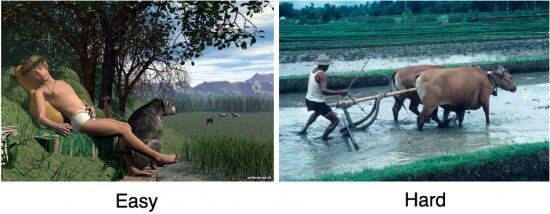
In addition to the logical appeal, genetic, linguistic and other lines of evidence bolster the idea that people were not only using animals for food but also for a kind of labor well before the Bronze age. And physics offers evidence, too, since Humans benefitted from a closer relationship with animals for reasons of thermodynamics as Thom Hartmann writes in The Last Hours of Ancient Sunlight:
Something important happened around 40,000 years ago…humans discovered that ruminant (grazing animals like goats, sheep, and cows) could eat those plants that we couldn’t, and could therefore convert the daily sunlight captured by the scrub and wild plants on that “useless” land into animal flesh, which we could eat.
To recap, first the Herder-Gatherer lifestyle allowed for periods of sedentism. Then, spending a lot of time in the same place would permit people to perfect the arts of smelting metals. Only then could Bronze age technology emerge and settled cities flourish.
An Alternative, Dairy Rich Paleo lifestyle: Herder-Gatherer.
Herding and gathering cultures such as the Bakhtiari of Afghanistan, recorded in the 1925 classic documentary Grass: A Nation’s Battle for Life, are neither fully nomadic nor fully sedentary. Instead, they migrate between specific locations following the seasonal rains that supply thousands of grazing animals with vast fresh pastures of rapidly growing grass–just kind grazers love best.
Unlike members of settled farming communities, who would have had relatively less access to animal foods than the hunter gatherer for a variety of reasons, herding and gathering communities would have perhaps relatively enhanced access, especially as human populations increased and, due to the success of hunter gatherers, large game populations decreased.

It is often suggested, within the Paleo movement, that wild animals are healthier than domesticated. This argument has been used to support the notion that members of hunting societies would eat animals that are more optimally nourished than animals available to members of herding societies. But this argument may not apply to truly traditional herding societies. Firstly, their human masters protect them against injury from predators and so they would be less prone to nutrient-sapping infections than their wild counterparts. And secondly, these massive human/animal encampments would scare off competition from other herbivores for the best grazing land, optimizing the domesticated grazers’ nutrition in comparison to their wild counterparts.
The number of herder-gatherer societies surviving to modern times far outweighs the number of hunter-gatherer, testifying to the success of the herding as a way of life.
Now we have another hurdle before us: Just because human were herding animals way back then doesn’t mean we were drinking their milk.
The Squirt Heard ‘Round the World
Consider this: What do you think would happen if, one moonlit night, a Nanny goat lost its calf to sickness or a predator, and was loudly expressing the pain of swollen, un-milked udders in such a way as to disturb the owners of the animal?
If we can agree that such a loud disturbance may have been enough to rouse Paleolithic parents from slumber, then what do you think a woman in this situation would have done? To calm the animal she might have done the same as she would for a sister who’d lost a baby: Encourage the expression of milk. And so, if we agree with the assertion that herding began as early as 40,000 years ago, and there is good evidence for this, then with this thought experiment we have humans milking animals possibly as early as 40,000 ago.
Of course, one thought experiment is pretty sketchy evidence. So we need to consider another line of evidence linking dairying with a Paleolithic lifestyle: The effect of dairy on adult height.
The 40,000 year old dairy revolution.
It happens that 40,000 years ago marks another significant event in our ancestral history: The ‘extinction’ of Homo neanderthalensis.
When bones disappear from the skeletal record, we must consider two possible causes. Either the species fails to reproduce (extinction) or the skeletal structure has changed (evolution). Most archaeologists now believe that birds descended from dinosaurs, which means many species of dinosaur may never have gone extinct. Instead, they evolved into modern-day versions of their Jurassic ancestors.
I believe a similar transformation occurred in our ancestral history due to a shift in diet. This is especially likely given that, thanks to the science of epigenetics, we now know food can change genes. Here’s a simple model for how this metamorphosis may have played out: Neanderthal man changed his diet in some profound way and that altered his genes, and his anatomy. In other worlds, Neanderthal man may not represent some dead branch of the evolutionary tree, but rather a branch on the limb from which Homo sapiens blossomed.
With this in mind, let’s now consider what we know about the biological effect of milk on growth and physical appearance.
We know that, aside from containing minerals and protein that allow our bones to grow in all dimensions (thickness, width, and height), fresh and unprocessed milk contains lactoferrin, a bioactive compound that appears to stimulate bone growth in such a way as to lengthen a person’s limbs and make a person taller. (Lactoferrin promotes preferential growth of primary chondrocytes before puberty.) Lactoferrin’s action on chondrocytes offers a biological explanation for the observation that dairying tribes of Africa tend to grow taller—with long, graceful limbs—in comparison to non-dairying tribes (the most extreme example of which would be pygmies).
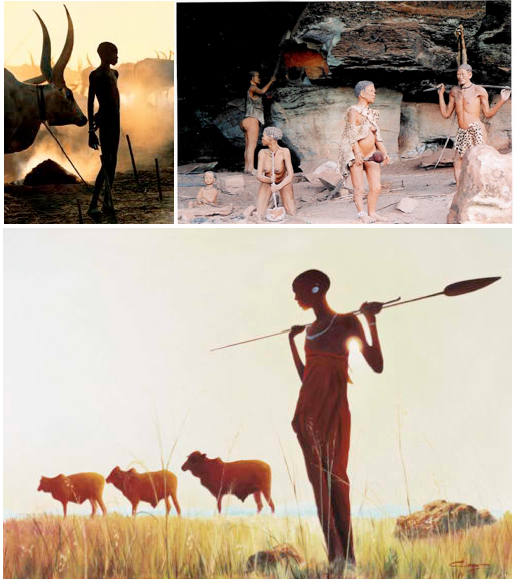
If milk can make people taller, and if people started drinking milk 40,000 years ago, we might expect something in the skeletal record of our ancestral past indicating a relatively abrupt increase in height. Is there?
It appears so. One of the most obvious differences between Neanderthal and early Homo sapien’s is height, with the former estimated to average five foot six, and the latter several inches taller. Much of this difference comes directly from limb lengthening. Neanderthal femurs, for example, average 19.55 inches and early Homo sapiens average 20.7.
Of course, all such archaeologic evidence is based on very small sample sizes and a hefty helping of extrapolation, so that the discovery of just two or three new skeletons may shift the evidence dramatically. Still, I think that these ideas give us a different perspective of how ancient peoples’ relationship with animals could have influenced our modern anatomy. We shouldn’t dismiss the idea of milk being Paleo simply because we’re not accustomed to the image of distant ancestors drinking milk. We didn’t used to imagine dinosaurs with feathers, or the brightly colored harlequin coat of a leftover-scavenging Tyrannosaurus rex. But that’s what makes science fun: New evidence invites us to revise the very images with which we form our worldview.
Right now, all around the world, there are people milking camel, sheep, cows, horses, goats and maybe a few more animals and this goes on in tropical, dessert, mountainous, and almost every other climate. With dairy’s current worldwide popularity, and the possibility that dairy has been directing our growth for as long as 40,000 years, then we have to consider the potential risks involved in depriving our genes of these ‘expected’ nutrients.
One of the reasons people eliminate dairy is that they can’t digest it very well. This begs the question, if dairy has been such a part of the human evolutionary narrative, why would it now give so many people tummy-troubles? That’s a good question. I addressed the lactose issue in last week’s post and will discuss other barriers to consuming dairy in the future, so stay tuned!
RELATED POSTS:
Real Milk: Learn the difference between pasteurized and fresh, and how it affects your health.
This Post Has 28 Comments
Comments are closed.
Note: Please do not share personal information with a medical question in our comment section. Comments containing this content will be deleted due to HIPAA regulations.







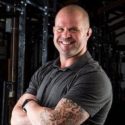


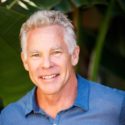








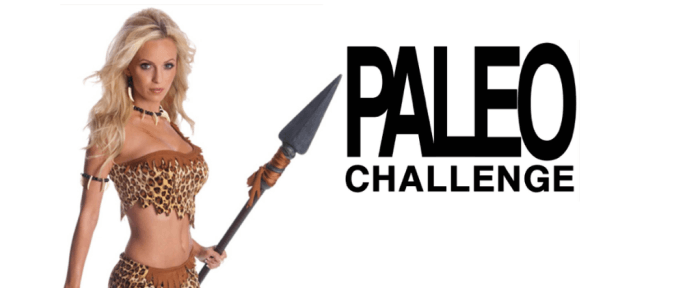
what about acne? doesn’t milk feed acne? and cause more inflammation ?
CONGRATULATION, THE BEST ARTICLE ON THE HISTORY OF DRINKING DAIRY. PERSONALLY, I DON’T HAVE ANY DOUBTS THAT DAIRY IS PALEO FOOD IN CERTAIN GEOGRAPHICAL REGIONS
[…] An excellent article from one of my favorite authors challenges a lot of common presumptions about early humans and their consumption of the dairy from herded animals in paleolithic times: https://drcate.com/is-dairy-paleo-part-2-revising-history-with-new-perspectives-on-flocks-of-goats-fe… […]
Dr. Cate, do you think the BCCA’s in milk are important for the body? I am asking because I do okay on milk but only small quantities, even if it’s raw. Do you think that about 5g BCAA’s and 3 or 4 grams glutamine supplementation would be okay for muscle gain just after a heavy workout? I am thinking of taking these right after a workout since they seem to be effective, but I don’t think I want to take more than 5 grams or so. Thanks a lot.
Carlos I think you might mean branched chain amino acids, which would be BCAA not BCCA. Processed milk protein powders of all kinds are not going to be any where near as good as plain old milk, yoghurt, or cheese for all the reasons described in Chapter 7 of Deep Nutrition. Whether body building or brain building, real food works better than processed/isolated heat-damaged compounds.
Thanks for the reply. Yes, I meant BCAA, sorry for that. I do own your book and it’s one of the reasons I love bone broths at least twice a week. I think I got a pretty good diet, heavy in organ meats (liver mostly), oily fish, grass-fed meats and gluten free because I think I do better without gluten. I was asking because I drink 2 cups of raw milk with a banana after a heavyworkout and I am thinking of adding BCAA and glutamine (~5g). Do you think this might negatively affect my body?Hope not!
Milk contains BCAA and the powdered forms will be badly degraded into potentially harmful substances. I find that patients taking protein powders feel better after they stop.
You might be interested in the observations in S.C. Gwynne’s fascinating book “Empire of the Summer Moon” about the Comanche hunter-gatherers. They did not milk the buffalo, but did drink the milk of lactating animals they killed, and considered the stomach contents of calves to be a delicacy! I’ve always believed that milk is as natural a dietary component as milk. Interestingly, Loren Cordain makes the comment that milk is “nothing but filtered meat,” but still rejects dairy. Weird.
Dr. Cate:
I have beem migrating in the direction of primal / paleo foods for three years or so. My sister recently gave me Deep Nutrition and I am enjoying it immensely. I have reversed my onset of diabetes, my gout, my high blood pressure, and dropped 60 pounds since going paleo / primal three years ago. However I was missing the arthritis benefits of the “bone soups” and cooking meat on the bone as well as benefits of offal. Thank you!
This regards my husband Juan. He respects a doctor’s authority way too much. He has also gone paleo and looks and feels great and his triglycerides are great, but he is still on his Simvastatin and has some memory problems.
We need to find a paleo / primal friendly doctor in the South Bay Area / San Jose, Los Gatos, Mountain View, etc. If a doctor told him to ditch the pills
Can you recommend and physicians or groups out here who are paleo friendly?
Daniel
I’ve just amended my “Make an appointment with Dr. Cate” page to help you out.
The address is: https://drcate.com/make-an-appointment-with-dr-cate/
and it’s under the heading “Where can I find a doctor who won’t put healthy people on statins?” (I get this question quite often, sadly)
Ohhh yeah, I actually got banned from paleo forums for stating that in my opinion raw milk is healthy, and also for suggesting our paleo ancestors could crack a nut (cashew)…seriouly! Sad state of affairs, truly sad. I got band for those comments, so I am highly skeptical of paleo. It seems more like a religion. I have been on a modified raw, traditional diet for 15 years. Way before paleo. I look 20, i am 36. Cheers.
Dr. Fit,
You refer to “Paleo” as if YOU have made a religion out of protesting it. I am highly skeptical of… PROTESTS. Congratulations on the success with diet and fitness. Let health be your religion, even if that means a huge reduction in protesting and arguing and so on…. 😉
Thank you for defending raw milk.
I have come to similar conclusions.
The paleo trend is a good thing, but their overindulgance in meat will lead to problems latter on I suspect.
Dr Fit
It’s funny you say that about the overindulgence in meat. I have seen patients doing Paleo who are getting joint pains. This is partly due to wrong cooking techniques (heat damages amino acids), and partly due to not getting enough variety of fats or volume water, which leads to a host of other problems.
Runner Joe, I’m just starting to run and am working on increasing distance and ramping up speed, but I typically do an 80/20 sort of thing: low-carb during the week, and then allowing some cheats on the weekend, so cravings don’t derail lifestyle. For instance, with the colder weather I’ve gotten cravings for Indian takeout on Fridays, with the rice and naan. And I think that when you run most of the time on VLC diet you become an efficient fat burner, but if you do replenish the glycogen stores it gives you some extra fuel to start with before you would switch over to burning fat. On another site (Mark’s Daily Apple), some distance runners who also typically don’t eat grains and standard carbs reported carrying dates along on marathons as an efficient energy source, albeit a carb source. I think you have to find what works for you, but your body should be better suited to using whatever fuel it has if you’re going LC or VLC at least 80% of the time.
As for 80/20, I find that the more I refine and hone the diet and lifestyle, the less I want sweets and carbs. Given the opportunity to have bread on the weekend, I’d still rather go without… most of the time. I think it’s about retraining what you want, or at least, what you think you want. Now, my wife is a different story… She’s disciplined during the week, has even better blood pressure and lipid profile numbers than me, but all the recipes she ooohs and ahhhs over are carbs, carbs, carbs!
So my advice, as novice to more experienced runner, is to keep following Dr. Cate’s nutritional guidelines and see if that doesn’t change how you fuel your runs. It may take time and patience. Also, if you do need carbs to fuel longer runs, stay away from styrofoam foods like bread and pasta and hit something super-dense like dates. Finally, another item from MDA, try replacing some of your weekly distance runs with sprints. Some folks say it improves their energy utilization. I’ve tried adding sprints to the end of my runs and in my limited experience it seems to help the next time I head out for a run. Cheers!
Hi Dr. Care,
I’m a marathoner who enjoys your site very much as I try to eat as Paleo as possible. I eat surprisingly few carbs for how much running I do and generally feel decent.
I don’t eat dairy but I’m considering it. I don’t est red meat. Only fish.
I recently eliminated wheat from my diet as well. I just finished your book and get the idea tfat low Carb is better. It seems to work for me. It also seems like modern wheat flour is something You avoid. I often need more energy for my long training runs. What type of bread and pasta do you reccomend? How much? I’m basically living off fish and veges. Sometimes its Just not enough. The amount of fiber I take in with veggies isn’t always runner friendly. Bathroom wise….
Any advice is greatly appreciated. Great book. Thanks!
Dear dr. Cate,
could you explain a little about insulinogenic effect of milk? Is this a cause for concern for susceptible individuals?
I have access to raw, pastured, full-fat milk and I consume a lot of it, mostly in the form of homemade raw kefir. On average, I drink a 1.3 litres of kefir per day. I also love unfermented milk, but I limit the amount of it to few glases per week (I can tolerate it very well, but keeping carbs intake reasonably low is hard when drinking milk regularly).
Generally, I eat very well but I am probably insulin and leptin resistant. I have omental fat, measure of my waist is 80 cm, my fasting glucose is 97 and my THS is near 5. And of course, I have constant problems with weightgain. All this is a result of consuming looots of carbs most of my life (I am 29). I now watch my carb intake and try to stay below 100g or at least below 150.
I wonder, is it possible that these big quantities of dairy are the reason for my continuing weight problems? Mark Sisson writes about dairy, even fermented dairy, being as insulinogenic as white bread or even more so. Is this true? Should I ditch the dairy or at least consume less of it?
best regards, mateja
Mateja
In Chapter 9 of Deep Nutrition I explain why cutting carbs below 100gm is required for normal health. For weight loss many people need to cut carbs much farther. My next book, The T.R.I.M. Solution, will adress the effect of excess carb and other barriers to weight loss in more detail.
[…] benefits of Raw Milk (just raw not talking about the other stuff)..and it just might be Paleo.. Is dairy paleo? (part 2) Revising history with new perspectives on flocks of goats, femur bones and … Primal since March 2011 Reply With Quote + Reply to […]
I’ve enjoyed reading your books and based on them (and others) have made changes to my diet. To milk or not to milk has been a real conundrum. Your current comments regarding this issue have not resolved this for me. First if the main point is to consume raw milk/products only, these products are not easily or financially available to me or to the vast majority of the population (this seems to be a different recommendation than one of your books which recommends raw milk first and pasteurized organic/grass-feed/whole milk or better yogurt as a healthy alternative). Are you now recommending raw only?
Dr Cate here, my counterpoints are in bold italics: No change in my recommendations. In Food Rules I list the heirarchy and will do so again in an upcoming post on the forms of dairy intolerance and their workarounds.<p) second,=”” much=”” of=”” your=”” data=”” seems=”” a=”” poor=”” choice=”” to=”” support=”” your=”” argument.=”” the=”” film=”” that=”” you=”” reference=”” shows=”” the=”” bakhtiari=”” of=”” afghanistan,=”” 50,000=”” people=”” who=”” trek=”” for=”” 48=”” days=”” twice=”” a=”” year=”” across=”” persia=”” (mountains=”” and=”” raging=”” rivers)=”” to=”” move=”” their=”” flocks=”” to=”” needed=”” pastures.=”” a=”” sobering=”” review=”” of=”” a=”” population=”” under=”” strong=”” physical=”” distress,=”” slipping=”” down=”” steep=”” mountainsides=”” and=”” swimming=”” for=”” their=”” lives=”” while=”” crossing=”” a=”” half-mile=”” of=”” freezing=”” rapids=”” holding=”” on=”” to=”” air-filled=”” goat=”” skins.=”” <p=””> I loved the film, and watching it the rigorous activity struck me as the sort of functional exercise that cross fit emulates. Certainly it weeded out the weak, but I would think our ancestors faced many similar challenges from time to time. When not migrating, they may have enjoyed lives of relative ease, more like the shepherd in the drawing.
This is quite different from the image you show of herding (looks like an idealized image representing a Roman or Greek herder (perhaps 4,000 years ago?) when domestication of plants and animals not to mention cities is in evidence. The Cave of Swimmers you reference is dated at about 10,000 years ago. And, from what I remember of my anthropology classes, the earliest current physical evidence of herding (the bones of domesticated animals are different from wild – mostly smaller/slighter bones and no/smaller horns) is also around 10,000 years ago.
10,000 years ago is considered within the Paleolithic era, to my understanding
Finally your height argument does not fit with the data that indicates homo-erectus (an even earlier hominin) was taller than homo-neantertalensis or early homo-sapien.
I suppose there’s more than one way to grow a tall hominid.
I appreciate and thank you for your work but I wanted you to know that I did not find this persuasive.
Dr Cate: Wonderful points, Wendy, and thanks for being willing to share. I far prefer intelligent discourse to attempts at pursuasion. After decades of learning why people do what they do I’ve come to understand that what people believe depends less on cognitive arguments and more on emotional value sets. I love and trust nature, so all my advise emanates from that simple basic belief, which not everyone shares.
Karen, extremely important points, thank you.
Though this comment may fit better in the previous article you wrote, I also wanted to mention the connection between gluten-intolerance and dairy/lactose-intolerance. Since lactase, the enzyme that breaks down lactose, “lives” on the ends of villi in one’s small intestine, and since celiac disease destroys and/or depletes villi, thereby depleting one’s lactase production and presence, I believe that many people who have a hard time digesting dairy actually have a deeper problem of digesting gluten-containing grains. Awareness has been raised in the last 3-4 years about the high incidence rate of celiac disease in the U.S., but it’s still WAY under-diagnosed. So, dairy gets the bad rap when it’s really our high-gluten American diets that are at the heart of the problem for many who suggest that humans aren’t well equipped, biologically-speaking, to digest cow dairy.
I REALLY like the moniker “herder-gatherer Paleo”. It makes sense to me. Maybe that’s just because I like cheese. 😉
[…] Is dairy paleo? (part 2) Revising history with new perspectives on flocks of goats, femur bones and … Hmmm seems like experimenting with an increase in whole raw dairy may be in order…. The only […]
Sounds logical to me (you know I’m a fan of logic ;-). Sharing this one on the Facebook page.
I can’t recall exactly, but isn’t there some evidence in the modern genome of a lack of Homo Sapiens Neaderthalensis? It’s been a couple of years since I read about tracking the various lineages of mitochondrial DNA, but I thought I remembered something about being able to track the main lineages all back to Africa, and there being a genetic bottleneck around 70,000 years ago when the human species was almost wiped out. Maybe the theories have changed by this point?
I’ve enjoyed reading your books and based on them (and others) have made changes to my diet. To milk or not to milk has been a real conundrum. Your current comments regarding this issue have not resolved this for me. First if the main point is to consume raw milk/products only, these products are not easily or financially available to me or to the vast majority of the population (this seems to be a different recommendation than one of your books which recommends raw milk first and pasteurized organic/grass-feed/whole milk or better yogurt as a healthy alternative). Are you now recommending raw only?
Dr Cate here, my counterpoints are in bold italics: No change in my recommendations. In Food Rules I list the heirarchy and will do so again in an upcoming post on the forms of dairy intolerance and their workarounds.
I loved the film, and watching it the rigorous activity struck me as the sort of functional exercise that cross fit emulates. Certainly it weeded out the weak, but I would think our ancestors faced many similar challenges from time to time. When not migrating, they may have enjoyed lives of relative ease, more like the shepherd in the drawing.
This is quite different from the image you show of herding (looks like an idealized image representing a Roman or Greek herder (perhaps 4,000 years ago?) when domestication of plants and animals not to mention cities is in evidence. The Cave of Swimmers you reference is dated at about 10,000 years ago. And, from what I remember of my anthropology classes, the earliest current physical evidence of herding (the bones of domesticated animals are different from wild – mostly smaller/slighter bones and no/smaller horns) is also around 10,000 years ago.
10,000 years ago is considered within the Paleolithic era, to my understanding
Finally your height argument does not fit with the data that indicates homo-erectus (an even earlier hominin) was taller than homo-neantertalensis or early homo-sapien.
I suppose there’s more than one way to grow a tall hominid.
I appreciate and thank you for your work but I wanted you to know that I did not find this persuasive.
Dr Cate: Wonderful points, Wendy, and thanks for being willing to share. I far prefer intelligent discourse to attempts at pursuasion. After decades of learning why people do what they do I’ve come to understand that what people believe depends less on cognitive arguments and more on emotional value sets. I love and trust nature, so all my advise emanates from that simple basic belief, which not everyone shares.
A well thought out, logical, and apolitical look at what is a likely scenario for how milk consumption first became part of the human diet. Wow! Dr. Cate you are a rarity in this golden age of dramatic hyperbole. Well done! You have my attention.
Hurd
Low heat is definitely better. But remember there are two considerations: Source and tradition. So another thing you want to do is find out what the animals ate and the quality of the soil ie organic or not. The more you know, the better you’ll feel about what you end up getting.
Hi Dr. Cate
Thanks for this and the last edition about milk. Right now I am looking for a source of fresh milk. In Alabama it is not legal to buy fresh milk form human consumption so I will be buying a lot for our cat. 😉 I do have a source for low heat pasteurized, non homogenized milk from a local health food store. Would this be an half way decent substitute? I’m not having a lot of luck finding a fresh milk source so far.
Thanks a lot. You are becoming one of my foremost teachers.